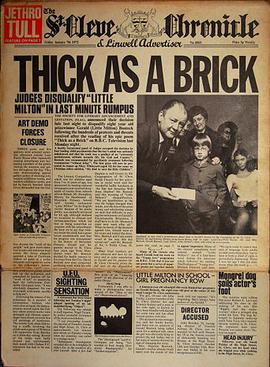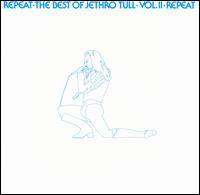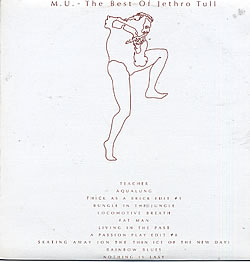
Jethro Tull are a British progressive rock band formed in Blackpool, Lancashire, in 1967. Initially playing blues rock and jazz fusion, the band soon incorporated elements of English folk music, hard rock and classical music, forging a signature progressive rock sound. The group's lead vocalist, bandleader, founder, principal composer and only constant member is Ian Anderson, who also plays flute and acoustic guitar. The group has featured a succession of musicians throughout the decades, including significant contributors such as guitarists Mick Abrahams and Martin Barre ; bassists Glenn Cornick, Jeffrey Hammond, John Glascock, Dave Pegg, Jonathan Noyce and David Goodier; drummers Clive Bunker, Barrie "Barriemore" Barlow and Doane Perry; and keyboardists John Evan, Dee Palmer, Peter-John Vettese, Andrew Giddings and John O'Hara.

Thick as a Brick is the fifth studio album by the British rock band Jethro Tull, released on 3 March 1972. The album contains one continuous piece of music, split over two sides of an LP record, and is intended as a parody of the concept album genre. The original packaging, designed as a 12-page newspaper, claims the album to be a musical adaptation of an epic poem by fictional eight-year-old genius Gerald Bostock, though the lyrics were actually written by the band's frontman, Ian Anderson.

Aqualung is the fourth studio album by the British progressive rock band Jethro Tull, released on 19 March 1971, by Chrysalis Records. It is widely regarded as a concept album featuring a central theme of "the distinction between religion and God", though the band have said there was no intention to make a concept album, and that only a few songs have a unifying theme. Aqualung's success signalled a turning point in the career of the band, which went on to become a major radio and touring act.

Repeat – The Best of Jethro Tull – Vol II is a 1977 greatest hits album from Jethro Tull, featuring one track which, up to the time of this album's release, had not been issued. The album's first volume was M.U. – The Best of Jethro Tull.

Ian Scott Anderson is a British musician best known for his work as the singer, flautist, acoustic guitarist, primary songwriter, and sole continuous member of the rock band Jethro Tull. He is a multi-instrumentalist who also plays harmonica, keyboards, bass guitar, bouzouki, balalaika, saxophone and a variety of whistles. His solo work began with Walk into Light in 1983; since then he has released another five albums, including the sequel to the 1972 Jethro Tull album Thick as a Brick, titled TaaB 2: Whatever Happened to Gerald Bostock? (2012).

Minstrel in the Gallery is the eighth studio album by British rock band Jethro Tull, released in September 1975. The album sees the band going in a different direction from their previous work War Child (1974), returning to a blend of electric and acoustic songs, in a manner closer to their early 1970s albums such as Benefit (1970), Aqualung (1971) and Thick as a Brick (1972). Making use of a newly constructed mobile recording studio commissioned and constructed specifically for the band, the album was the first Jethro Tull album to be recorded outside of the UK, being recorded in tax exile in Monte Carlo, Monaco.

War Child is the seventh studio album by Jethro Tull, released in October 1974. It was released almost a year and a half after the release of A Passion Play. The turmoil over criticism of the previous album surrounded the production of War Child, which obliged the band to do press conferences and explain their plans for the future.
Barrie "Barriemore" Barlow is an English musician, best known as the drummer and percussionist for the rock band Jethro Tull, from May 1971 to June 1980.

John Evan is a British musician and composer. He is best known as the keyboardist for Jethro Tull from April 1970 to June 1980.
"Aqualung" is a song by the British progressive rock band Jethro Tull, and the title track from their Aqualung (1971) album. The song was written by the band's frontman, Ian Anderson, and his then-wife Jennie Franks.

M.U. – The Best of Jethro Tull, released in 1976, is the first proper greatest hits album by Jethro Tull. It spans the years 1969 to 1975. The earlier Living in the Past (1972) compilation mainly dealt with non-album material, but this album only features one previously unreleased song, "Rainbow Blues".

"Locomotive Breath" is a song by British progressive rock band Jethro Tull from their 1971 album, Aqualung.
"Cross-Eyed Mary" is a song by the British progressive rock band Jethro Tull from their album Aqualung (1971).

The Best of Jethro Tull – The Anniversary Collection is a greatest hits album by Jethro Tull, released in 1993. It includes some of the band's biggest hits from 1968 to 1991.

The Essential (2003) is a greatest hits album by Jethro Tull, digitally remastered. The songs included and their order are the same as Tull's first greatest hits album, M.U. – The Best of Jethro Tull. It is not to be confused with the similarly named Jethro Tull compilation "Essential", released in 2011.
"Mother Goose" is a song by the British progressive rock band Jethro Tull. It is the fourth track from their album Aqualung which was released in 1971.

"Hymn 43" is a song by British progressive rock group Jethro Tull. It is off their Aqualung album and was released as a single by Reprise Records. The song reached No. 91 on the Billboard Hot 100.

Scott Hammond is an English drummer. He plays with Ian Anderson and has also toured and recorded with Jethro Tull itself. He has been described as a "Jazz drummer with rock influences".

"The Witch's Promise" is a single by the British rock band Jethro Tull, released in January 1970, on the Chrysalis label. It reached No. 4 in the UK Singles Chart, and was promoted by an appearance on the British chart show Top of the Pops. The B-side was "Teacher", an alternate version of which later appeared on the US release of the album Benefit. In the U.S., the single was released on the Reprise label.















